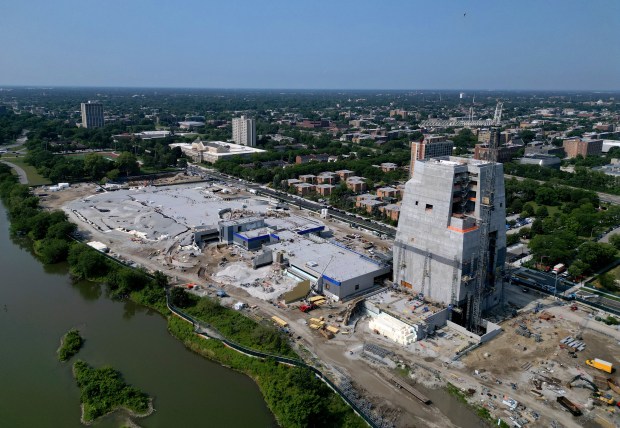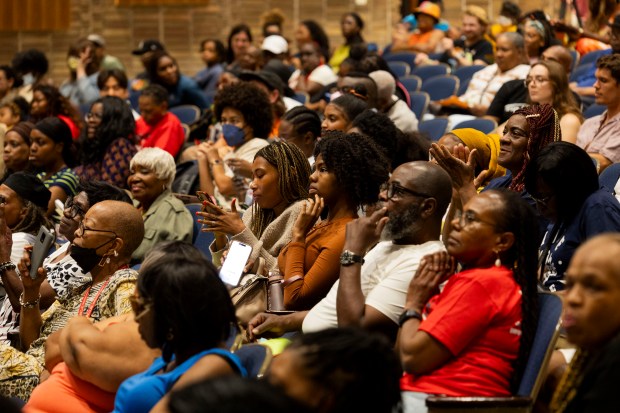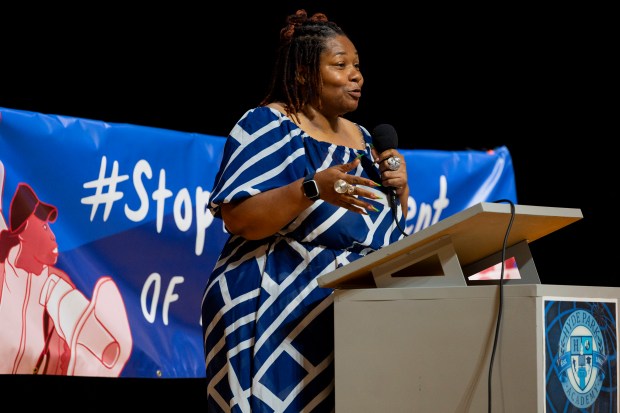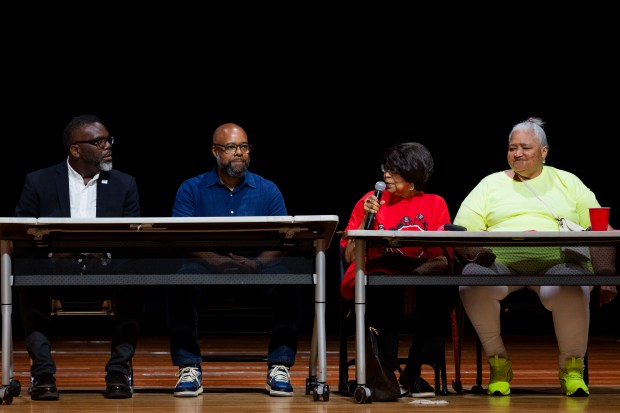Weeks after Barack Obama donned a hard hat to celebrate the topping off of his landmark presidential center in Jackson Park, 81-year-old Pat Hightower fretted about time running out to save the fabric of nearby neighborhoods.
A resident of Woodlawn and former social worker turned organizer with Southside Together Organizing for Power, she told the Tribune she’s heard not just from fellow seniors but from others about how their rent has gone up by hundreds of dollars in recent years. She’s heard of apartment buildings switching to condominium units longtime residents can’t afford to buy.
The changes are “moving people out who have lived here for years, have raised children here, have homes … went to school here, went to church here,” Hightower told the Tribune.
“One guy I talked to several months ago, his rent was $900. The owner told him he’d be charging $1,500 and told him once the Obama Center was completed there would be people who moved in who could afford the rent,” she said.
Hightower joined hundreds of the Obama Center’s neighbors to pack the gym of Hyde Park Academy High School on June 22. The so-called Community Benefits Agreement coalition met to rally and press Mayor Brandon Johnson about whether he stood by them in their fight to get the City Council to pass a slew of protections for renters and homeowners.
Despite the mayor’s pledged support to prevent displacement of residents near the center, an ambitious, multi-million dollar package of new programs for South Shore has been idling in the council’s Housing Committee since October. While local Ald. Desmon Yancy backs the proposal, some community leaders oppose it on the grounds it prioritizes lower-income renters over South Shore property owners.
Advocates hoped with the mayor’s help the ordinance could have a hearing later this month and a final vote before budget season kicks off and bogs down other city business.
Members of the South Shore CBA coalition used the gathering to discuss how rent hikes, steep deposits or subpar living conditions had repeatedly forced them to move. South Shore, one speaker noted, remains the city’s eviction capital.
Hightower took to the stage to quiz Johnson, telling him the longer council delays passing legislation to help current residents, the greater the risk they will be pushed out by wealthier newcomers as the center’s opening looms in 2026.
She asked whether the mayor would support a hearing on the issue of displacement and on the South Shore Housing Preservation ordinance before the end of the year, requesting he give her a yes or no answer.
“So there’s going to be -–” Johnson began, before members of the crowd yelled back “Yes or no!”
“Don’t boo me yet, hold on a second. You got to at least wait until my third term to start booing me,” Johnson said.
He went on to pledge that there would be a hearing about “how we expand and extend” a pilot program designed to connect attorneys with people involved in eviction hearings. Launched under former Mayor Lori Lightfoot, that program has had the greatest benefit to South Shore residents, Johnson said, with more than 90% of all participants able to “avoid formal eviction.”
The ZIP code encompassing South Shore has had the highest number of completed evictions in Cook County each year between 2019 and the end of 2022, according to data from the county sheriff.
Johnson’s own ordinance to make that pilot program permanent has also sat in committee since September. A hearing on it has been scheduled for July 31, but the meeting is dedicated solely to right to counsel, not the South Shore ordinance.
While South Shore isn’t a gentrification flashpoint like Pilsen or near the 606, pressures in the lakefront community are rising. According to DePaul University’s Institute of Housing Studies, the neighborhood still has a higher share of rental units that fall below $900 (a standard affordability measure) compared to the rest of the city. But the share of those units in South Shore declined by 38% between 2010 and 2022, more than the 31% citywide average. Roughly 70% of South Shore residents are renters, according to an analysis of census data by the Chicago Metropolitan Agency for Planning.
Similarly, while still more affordable than the citywide average, median sales prices for single-family homes, condos and 2-4 unit buildings also rose faster in South Shore than the city between 2019 and 2023, according to institute data.
Rising home prices can be a double-edged sword: longtime homeowners recoup equity when neighborhood values rise. Higher values also welcome other outside investment and amenities.
But rising values can sometimes mean unaffordable taxes and a taller barrier for renters to become owners.
“Our friends, family and neighbors are being displaced as we speak. We know that this will continue unless there is meaningful legislation passed to protect our neighborhoods,” Hightower told Johnson.

Johnson also highlighted a $15 million South Shore condo and co-op preservation fund, another Lightfoot-era program that helped pay for home repairs and deferred maintenance in the hopes of preventing condos from de-converting into more expensive rentals.
While he said he was committed to “fighting alongside this coalition,” Johnson put the onus back on the crowd, saying they “must go beyond the voices that are already convinced” and needed “more hands swinging.”
Yancy, 5th, the ordinance’s main sponsor, echoed the mayor’s fighting words at the same event. “Frankly, this is a fight for the soul of South Shore. It’s not just about affordable housing,” he said, alluding to unnamed Black aldermen he said were opposed to the ordinance.
His two other colleagues whose wards overlap South Shore — Ald. Greg Mitchell, 7th and Michelle Harris, 8th — have not backed the proposal. Harris, whose ward only has a small slice of South Shore, said last week she was neutral.
Mitchell, who is the vice chair of the Housing Committee where the ordinance is currently stalled, declined to discuss it last week. “It’s a work in progress,” he told the Tribune. “It’s nothing to talk about.”
In February, Yancy got into a literal scuffle with Mitchell, telling the Sun-Times then that Mitchell promised to “kill” his ordinance.
Mitchell denied ever assaulting Yancy and said the two worked through their disagreement.

“There are people who don’t believe that folks are housing-burdened,” Yancy said at the CBA event. Census data for the neighborhood suggests roughly half of residents spend 30% or more of their income on housing.
“The average one bedroom apartment costs around $1,200 a month where the median income in South Shore is around $2,000 a month. Like the fact is, the math don’t math,” Yancy said.
Yancy’s predecessor, former Ald. Leslie Hairston, 5th, was a skeptic of the CBA. She previously argued the neighborhood already had a high concentration of subsidized renters and that longtime homeowners should be prioritized for protection or reap the benefit of rising values.
Those renters include residents of Section 8 housing and thousands who relocated to South Shore with CHA vouchers after the demolition of public high-rises during former Mayor Daley’s Plan for Transformation.
More recently, that’s also included migrants. Through May, the ZIP code that covers South Shore had the highest number of migrants who rented there using state assistance to find housing outside the city’s shelter system. Some residents also balked last year at plans to use the shuttered South Shore High School as a temporary shelter for migrants, frustrated that the crisis was prioritized over the needs of longtime residents who have long asked for more city resources and investment.
Given how much the ward has had to shoulder with few wrap-around supports for the neediest individuals, Hairston said she wanted to see more resources dedicated to social services, and compromises to the ordinance that secure a greater “balance” of both middle and low-income people in the neighborhood. “You need to go more towards a mixed income,” Hairston said.
A 2022 quality of life plan developed by neighborhood groups — including the South Shore Chamber of Commerce — was similarly focused on fostering a middle-class enclave: boosting home ownership and de-emphasizing broad assistance for low-income renters. It noted those renters are vulnerable to market forces, creating “instabilities for individuals and families” that reverberates across the neighborhood.

The high number of subsidized renters “puts pressure on developers and landlords seeking to appeal to more middle-class renters,” the report said.
Low home ownership levels, it continued, shape the neighborhood’s makeup and “ability of community residents to contribute to economic development.” It recommended efforts focus on keeping existing home and condo owners in the neighborhood and helping current renters buy property.
Some of the chamber’s proposals overlap with the CBA ordinance. including calling for access to legal help, giving tenants the right to buy properties their landlord intends to sell, and funding the redevelopment of vacant homes. CBA organizers say they were purposeful about including plenty of help for homeowners in the ordinance.
The timing, Yancy said, is urgent: The council typically takes an August vacation and budget season kicks off in October. “We have a very short window. If we don’t pass an ordinance in September, we go into budget season and it’s a wrap for this year.”
As of Monday, no hearing on the CBA ordinance had been scheduled.
Yancy’s ordinance enshrining the CBA coalition’s proposals calls for a raft of new programs and protections for residents costing tens of millions of dollars, largely tapping the city’s Affordable Housing Opportunity Fund to pay for it. The ordinance would:
- Create a registry of rental properties at the city level. Ban move-in fees. Cap rental application fees and security deposits. Provide $5 million in rental subsidies for low-income renters.
- Pilot a new $15 million Office of the Tenant Advocate to provide emergency housing and help renters navigate landlord-tenant law.
- Create a $1.5 million loan fund for the purchase and rehab of vacant homes. In exchange, those homes would have to be sold or rented as affordable. Create a $3 million program for developers to buy or refinance apartment buildings if they maintain affordability for 30 years.
- Grant $12 million to rehab existing vacant homes and $20 million for longtime homeowners to fix up their houses, and provide $2.7 million for in-debt homeowners to pay off past-due property taxes.
- Offer city-owned lots for sale to affordable housing developers for $1. Expand current rules to allow condos and townhouses to be built on South Shore lots and require that 166 city-owned vacant lots be developed into affordable rentals. Most of those units would be reserved for those earning 30% of the Area Median Income, or $33,630 for a family of four. Those affordability restrictions would stay in place for 99 years.
After much wrangling, the city’s Housing Department reached a deal granting a raft of protections to residents in Woodlawn — just west of the Obama Presidential Center — in the fall of 2020.
Local Ald. Jeanette Taylor, 20th, said the issue is personal: Her own rent in Woodlawn jumped recently from $1,000 to $1,500.

Even though she’s said the Woodlawn preservation ordinance helped spur the soon-to-be opened affordable housing development at 63rd Street and Maryland Avenue, other programs have been slower, residents have complained. City officials say six multifamily loans have closed as a result of the Woodlawn ordinance, which helped preserve 47 units.
But as of this March, three single-family loan or grant applications have either been cancelled or put on hold by potential borrowers, the Housing Department said.
“We’ve got to have a city that does right by us” and spends the money it has on programs to make the city more affordable, Taylor said at the CBA event. “Y’all know we spend like $80,000 on flowers down Michigan Avenue?”
Chicago Tribune’s Jake Sheridan contributed.
aquig@chicagotribune.com





